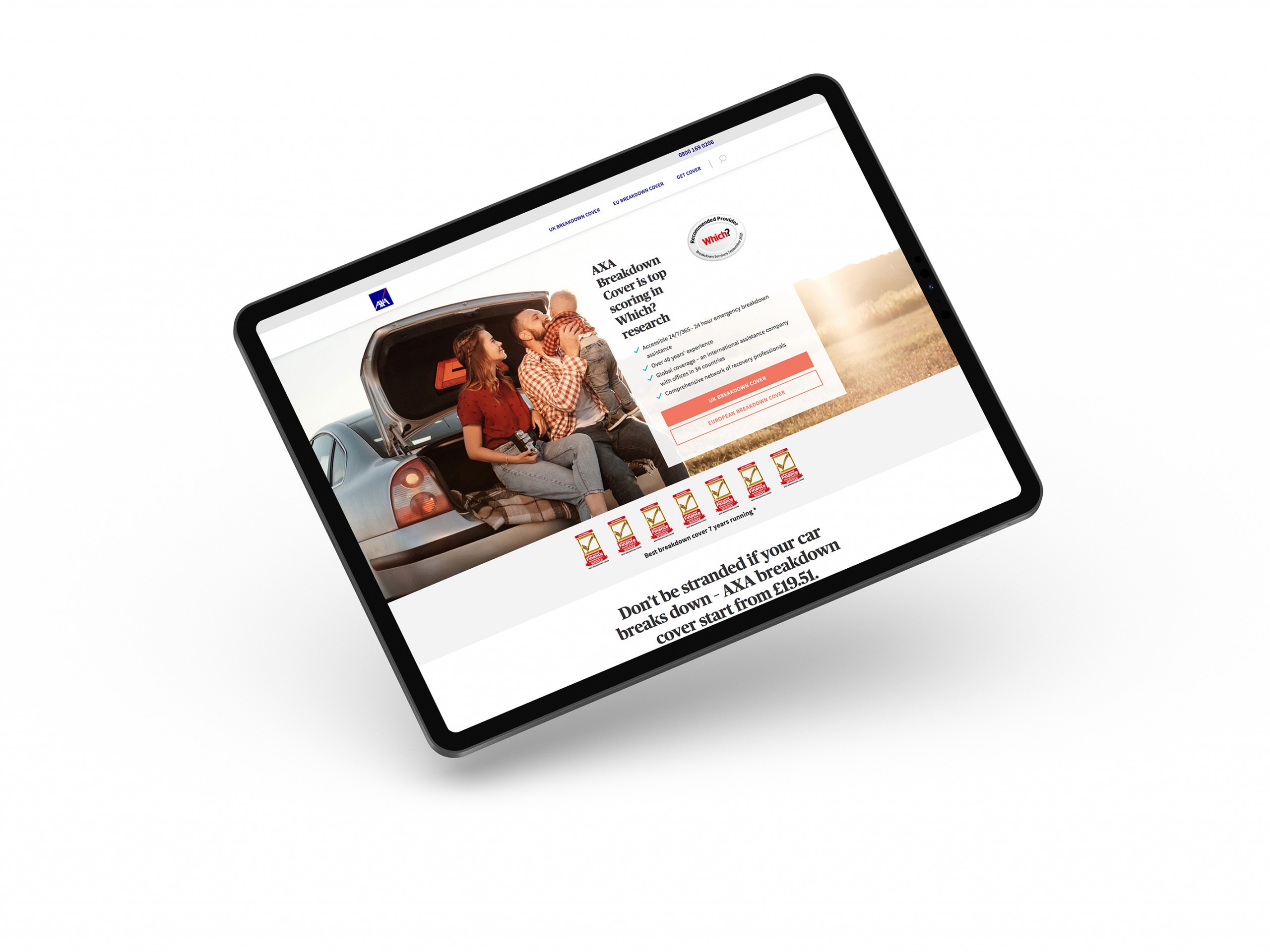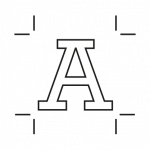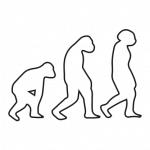Creatively led product
We are not techies, but we have built major websites and digital tools. The Daisy creative director becomes your creative in the room with your techies. They’re there to keep everything on track, supporting the brand, ensuring messaging works with your audience and the content strategy and promotional strategy are joined up.

AXA Quote and buy Breakdown cover cover https://www.axabreakdown.co.uk/
What we do
Creative Direction
This is about your brand. What you need to say and how you’ll say it. What will the experience be like, and how will it contribute to the overall brand experience? How will it dovetail with other channels and offline? What content will you need, and what journey do you want customers to go on, not just her eon your website, but before they arrive and after they have left?
Creative Challenger
This is the cold eye to keep everything on track. The delivery is meeting the ambition. The art direction (UI) is tight, the brand is shining through, usability and integration is meaningful. Copy is working and marketing opportunities are maximised. This is having a Creative Director on your team holding the tech guys to standard. Someone who can talk their language and not be bamboozled by them. And who can help them find elegant solutions when problems do occur.
Wireframing
Wireframing is as much a creative exercise as it is a technical one. This is where the story is structured, the messaging tested and the cadence of the story you tell is established. Wireframing is where all the strategic creative decisions are made. It brings together everything we know about the market, customer, brand and messaging. It defines customer journey (UX) and layout (UI). Which makes it a Creative Directors job. We use online tools for comment and to share progress.
UX Research
This is as long as a piece of string. A lot of the planning can be done desktop using data insights. Some requires interview and groups, at other times you need to conduct UX research. In that case we work with our own partners, write and define their brief and ensure progress and delivery. As the creative lead we’re best placed to make sure we get insights that are actually worth having and learning that we can use.
• Persona development
• Interviews
• Groups
• Key messaging
• Proposition testing
• Validation
• Customer Journey mapping
• Usability testing
• Prototypes
The UX
We are experienced as the creative lead on the UX team ensuring we get visitors as smoothly as possible to where you want them to be. It’s about making the customer journeys work, which is all about persuasion, reassurance and hand holding as much as it is about satisfying interactions. Great UX is about brand, messaging and tech. And it’s telling the DEV guys what to track and what you need to say and do to make the experience fulfilling to both visitor and brand.
Creative Audit
You’ll do an SEO Audit, a Tech Audit, Social Media and Competitor Audit. But what brings these all together, identifies holes and creates tangible, actionable recommendations is the Creative Audit. We’ll look at messaging, style, content strategy and brand fit. We’ll identify inconsistencies and where things need to be improved, kept, added or completely re-thought. We’ve done this for a number of clients because it makes the creative and planning stage so much easier, ask us about our experience.
Customer journey planning
We help our clients plan thorough customer journey(s) from beginning to end. Our work covers three areas. First, what drives people to the website (like content, campaign, brand messaging). Second, the onsite journey by finding ways to make messaging more relevant, pushing tech for more dynamic tools, delivering messaging that prompts, reassures, supports and guides towards the outcome we want – ensuring all parties are satisfied by the experience. Third, take control of the long tail (remarketing creative and customer engagement and retention plans and creative).
CX Mapping
The customer’s touch points with the brand. It’s important to understand the context of an application you build, and how online inter-relates with real world experiences. It’s about brand and consistency and also about flex. If you want your website’s customer journey to work, you need to know where the customer/user’s actual journey might have started and where it might go so that what we do online supports the customers total brand experience and can influence desired outcomes more effectively.
The UI
We’ve designed a number of major websites. UI brings the logic of the UX to life and delivers the frame work for your content to sit in. But good web design works hard – you’ve got to know audience, be experienced in story telling, know what the content is going to be and what creative messaging you’ll need to have. It’s a job for a creative director who thinks audience messaging, segmentation and content and can make sure that the whole thing hangs together, communicates well, works hard and achieves what the business needs it to achieve.
Web Design
We don’t do the HTML, we get partners in the Daisy Chain to do that for us. What we do is the design, the PSDs and wireframes and we oversee the HTML build. Good web design is design that works hard, UX led, communicates the brand’s values and tells the story in an appealing way. Design is a hard-nosed marketing tool that doesn’t look like its driven by hard-nosed marketing objectives.
Web and social content
Great content comes from being close to a business, the stories, the people behind them and knowing the audience. We think that great content is authentic content so we work to help your people deliver it, and to grow in confidence delivering it. We’ll create the granular content strategies and key assets and content that will set the tone, but we believe we then should step back, mentor your people, support them and let them get on with more of it themselves.
Key messaging and copywriting
It’s about keeping it short. And sweet. And UX focused. Even when you have a lot to say. People don’t like to read on screen, in fact, mostly they don’t want to read your story at all. If you’re lucky they’ll absorb a few key beats, enough to want to read a little more. We can help set copy tone, identify key messages, key words and deliver copy that supports your SEO.
Prototypes
If wireframe prototypes aren’t enough building a functioning prototype of all or part of a site or tool can check usability and thinking early on. There are different options available, the trick is to identify the need, get one that satisfies the need, and do it cost effectively.
The Build
We don’t do this ourselves, but our network partners or your DEV. guys do. What we do is lead it. And keep it true to the UX plan. We specify what the backend needs to do so that the website delivers for the business and to the creative vision. We’ll spec what Admin looks like, it’s use-ability and ensure it works logically for non-techie administrators. We have three DEV. teams we partner with based on budget and requirements and clients end up with direct relationships with them. These are a PHP team (most common open source language), a wordpress theme (most cost effective for smaller projects, MVP, proof of concept or prototyping by adapting existing templates or building in wordpress) and a .NET team. When we build Apps we go to specialist App developers, when we build AR applications we use a market leading AR provider we’ve worked with in the past. We believe in working only with real experts and handing that relationship directly to clients.

Discover
Understand the situation, and the problem we need to solve. Focus on the customer. Insights. Their needs, wants, behaviours and objections. Competitors and the market.

Design
The story we need to tell. Strategies planned, propositions, messaging and customer journeys mapped out. Concepts and wireframes and creative direction agreed.

Deliver
The deliverables. Everything made, signed, sealed and delivered. Designs completed and all copy written. Images created, pixel perfect artwork, all strategies completed. And sent live and hand-overs done.

Develop
Evolving the product. We’ll have agreed a testing strategy, but what comes next? We’ll review results and agree changes. Reset our KPIs and design and deliver the next stage




